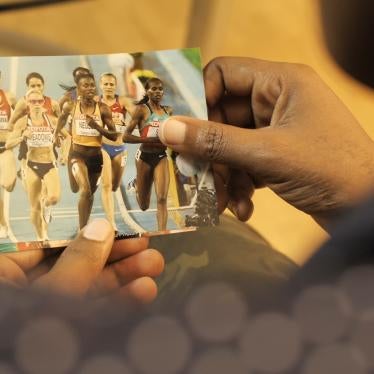What is it that singles women out?
Often it is just that they look different, less “feminine” than men, and it often is men, in charge of the national or international sports federations, who think they should.
These policies disproportionately target women from the global south, specifically black and brown women. It is important to note that there aren’t any similar rules governing men’s bodies.
There is evidence of research studies by doctors affiliated to the World Athletics where women’s bodies have been investigated and operated on. They treated these women like guinea pigs. They would not have done this to an athlete from Europe or America.
Do the athletes give consent to be tested?
Not informed consent. They are normally not told exactly why they are being tested or what is going to happen. In the case of one athlete, she was told it was about high performance, others are told various things that aren’t true.
There is also no privacy, the coach is there when the physical exams are done. Then the women are pressured into surgery or hormone therapy as the only ways they could possibly be allowed to compete in their preferred event.
Often these women start competing because the prizes are a way to survive, to pull their family out of poverty. They love sports and see it as the thing that can change the fate of their family. And then suddenly they are told they don’t have a chance unless they take irreversible medical steps.
They are also told not to talk about it and to come up with some excuse about why they are not competing. This creates a feeling of shame for them, like there’s something wrong with them and they shouldn’t talk about it. It makes them feel inadequate, like they’re not the “correct” kind of woman. Athletes told me it feels like a way of telling them they aren’t good enough.
Are doctors willing to perform these tests without consent?
This isn’t a normal doctor-patient relationship. The athletic federations that are directly connected to the doctors are both requesting the invasive treatment and being given information by the doctors about the athletes. The athletes don’t have any autonomy around this process. Their medical information is passed on from the doctor to the athletic federation that decides their future and whether they will be allowed to compete.
Some people believe that if a woman doctor performs the test then it is fine. But it isn’t necessarily so. It is still an extra pair of eyes and hands on your body in a way you haven’t consented to. That is not fine.
The women are told not to speak about it because of “confidentiality,” but this protects the federations and the people performing the tests and not usually the athletes.
The World Medical Association has said these tests shouldn’t be performed. Has that made a difference?
Honestly, no. The WMA made it clear that the sex testing regulations are unethical and instructed doctors not to implement them. But the doctors are not controlled by medical authorities, they do what their collaborators – the athletic federations – tell them to do, and they follow what the international bodies say. There needs to be a change in sporting policy at the international level for these harmful practices to stop.
What happens after women are told they can’t compete?
Often these women start competing because of the prizes. Sometimes the prize is some food, and one woman told me she won a cow as a young girl, which meant her family could have milk every day. Sport, competing for the national team, it’s something to aim for because it pulls you out of poverty, it helps your family. Athletes in many countries get lifetime government jobs after they finish competing if they did well and brought pride to their country.
When that goes away, often the woman’s family stops supporting them. Especially because there are all these rumors around why they had to stop competing – that there is something shameful about them. These women can lose their support network overnight and they don’t even get told exactly why.
There are also long-term effects for these women if they try to stay in sports. They are constantly under scrutiny, they start to feel unsafe, people gossip about them constantly. It is a very hard thing to deal with when no one has told you why it is happening in a way that you understand.
South African runner Caster Semenya is probably the most famous case of gender testing. Is that where most people’s knowledge of these examinations comes from?
I am privileged to know Ms. Semenya, and she is a wonderful and extremely resilient champion, both on and off the field, who has a very important story to tell. But she is not the whole story. She was already at the top of her career when this happened and people are, rightly, rallying around to support her. She has support in a way that a lot of these women, at the start of their careers, often young and alone and not aware of their rights, do not have. It is, to my mind, a good thing more people are aware of these horrific tests now, but even with that, people don’t realize how many women it affects and what they go through, what they have to overcome.
She is a wonderful champion, but the media should highlight other stories too, of the women who don’t rise to those heights. The women who are just mid-level, proud to represent their country, and trying to build a better life, and then they have it ripped away.
What can be done to protect those women?
Education on rights – many athletes didn’t even know that the court of arbitration for sport existed, let alone that they could take their case there. I have been working with women athletes for years trying to make them aware of their rights. It is no coincidence that these policies affect women from poorer countries, where they don’t have the same level of awareness about their rights.
I advise athletes not to allow federations to communicate with them verbally. It is important to have evidence of what the federations ask athletes to do in writing. If they ask for every communication to be in writing, federation officials realize that they must take that athlete seriously and treat her respectfully.
Women are now challenging these policies in courts of law, both national and international. This is a recent development and it makes me happy to see that more and more women athletes from Asia and Africa are becoming conscious of their rights.
What about the testing policies?
They need to end. At a national level, and at an international level. There are some women who compete nationally, and then just as they are about to make it to the international stage, they get tested and dropped. There’s major downstream impact from the global regulations. That’s because the national federations or sport ministries see these international federation policies and think they have to test first. All levels of sport need to stop these tests now.
Is there anything that makes you hopeful things can change for the better?
These women have been scrutinized for so long and now, finally, that is being switched and it is the federations dealing with scrutiny for what they have done.
This report is the first time the world is truly hearing the voices of some of the women affected by these policies. Annet Negesa, the Ugandan runner who was sex tested and ruled ineligible, broke her silence for first time in an interview to Human Rights Watch last year. That was incredibly brave. Finally, after more than a decade of work, the world is paying attention.
I believe it is extremely powerful that all the affected athletes I am working with are now refusing harmful medical intervention. Dutee Chand and Caster Semenya have spoken openly about not succumbing to any pressure of taking medical steps. They have inspired athletes across the world to switch to a completely new, unrestricted event, rather than consent to these harmful and irreversible medical interventions. Switching events often outs them as having high testosterone. But that is not deterring them. It is a clear message to the World Athletics: “Enough is enough.”
** This interview has been edited and condensed




